In this presentation, Gary Klein shares important information about air source heat pump water heaters (HPWH), with particular attention paid to where the warm air comes ...
Loop System Hot-Water Heating Q&A
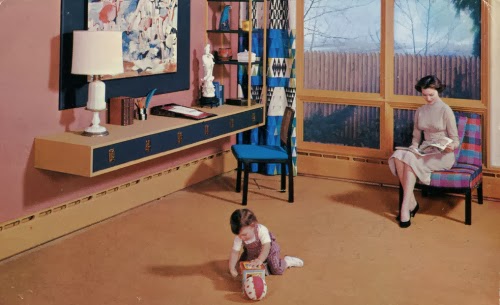
Q: What's loop hot water heating?
A: It's the simplest method of heating with hot water. Each zone consists of a single loop made up of the pipe and the radiators. The water flows out of one radiator into the next.
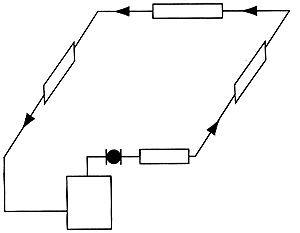
Q: What sort of radiators do most people use with loop hot water heating?
A: Usually fin-tube baseboard. In fact, it was this type of radiation that first made the loop method of heating so popular in the early 1950s.
Q: Why is baseboard so popular?
A: Most heating contractors use baseboard radiation as perimeter heat, running it from room to room along the outside walls of the building. Piped this way, the baseboard radiation becomes the piping as well as the means for transferring heat from the water to the air. Compared to earlier methods of heating, the baseboard loop system is inexpensive and relatively foolproof.
Q: Does this mean I have to use baseboard radiation if I want to install a loop system?
A: Not at all. You can make a loop system with just about any type of radiation. All you have to do is pass the water from one radiator to the next in a series.
Q: Is there a drawback to using other types of radiation in a loop system?
A: There can be a drawback to using any type of radiation in a loop system, and that includes baseboard radiators. Your success depends on how accurately you sized your radiators to the heat loss of the rooms they're going to serve. If you oversize the first radiators on the loop, the water may be too cool by the time it reaches the last radiators on the loop.
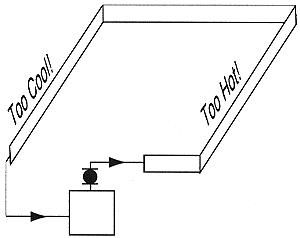
Q: What sort of problem would that give me?
A: The last radiators might not be able to heat the rooms they serve on the coldest days of the year. Your system would be out of balance.
Q: How likely am I to run into this imbalance problem?
A: It all depends on how the builder laid out the rooms and whether or not the people leave the interior doors open or closed. Most installers run baseboard from wall to wall. This looks neat, but it has nothing to do with how much heat the room needs on a given day. Too much or too little radiation leads to imbalance and discomfort.
Q: Can you give me an example of this?
A: Sure! Let's say you're putting a baseboard loop system into someone's house. The first room the loop enters is a bedroom which measures 15' X 15'. If you run baseboard around the perimeter, you'll be installing 30 feet of element. Since each linear foot of baseboard puts out about 600 Btu/hr (when the average water temperature is 180 degrees F), your radiator will be pumping about 18,000 Btu/hr into that bedroom. Suppose the heat loss of that room is only 8,000 Btu/hr on the coldest day of the year? You'll be overheating the room every time the system comes on.
Q: Won't the thermostat just turn the circulator off if the room gets too hot?
A: That depends on where the thermostat is. Suppose it's not in the bedroom. Suppose it's in the living room. Is there enough baseboard in the living room to shut off the thermostat before the bedroom overheats? Maybe someone opened the front door and there's a cool breeze hitting the thermostat. And keep in mind that since the loop goes to the bedroom before it goes to the living room, the water in the bedroom radiator will be hotter than it is in the living room radiator. That also contributes to the imbalance.
Q: So in a case such as this, would it be smarter to route the loop through the living room first?
A: It depends on whether or not the people living in the house like a cool bedroom. If they do, it would make sense to send the hottest water to the living room first, but remember, there are probably other bedrooms to consider as well on this loop.
Q: How can I solve these imbalance problems?
A: The best way is to size the radiation to the heat loss of the individual rooms. However, if you've already installed the baseboard you can cut down on the amount of heat coming out of each section by closing the dampers.
Q: How does that affect the amount of heat coming out of the radiator?
A: The damper slows the flow of air through the radiator.

Keep in mind this type of radiator works by convection. The air surrounding the radiator picks up the heat from the hot element and rises. Colder air enters the radiator from the bottom to take the place of the rising hot air. If you close the damper, you slow the movement of air and decrease the radiator's Btu/hr output.
Q: Suppose I close the dampers and there's still too much heat coming out of the radiator. What can I do then?
A: You could wrap a part of the element in aluminum foil. This will decrease the radiator's surface area and decrease the transfer of heat from the metal to the air.
Q: Could I also remove some of the fins from the baseboard element?
A: Yes, that would work too. By removing the fins, you've decreased the radiator's surface area. Less surface area means less heat transfer.
Q: Suppose I lower the temperature of the water. Wouldn't that also give me less heat in the room?
A: It sure would, and this is a good time to look at the way radiator manufacturers rate their units.

Here are the ratings for a popular brand of 3/4" copper fin-tube baseboard. As you can see, when the average water temperature of a 4 gpm flow through the baseboard is 180 degrees F, each linear foot of baseboard will put out 610 Btu/hr. However, if you lower the average water temperature to 140 degrees F, each linear foot of baseboard will only put out 340 Btu/hr.
Q: When do I need the hotter water?
A: When the outside air temperature drops toward the design temperature. These are the things you consider when you first size the job. You begin with your heat loss calculation. Let's say you want it to be 70 degrees F indoors on a 0-degree F day. Your heat loss calculation may tell you that a given room will lose 6,100 Btu/hr on that day so you figure the room needs 10 feet of baseboard because each foot puts out 610 Btu/hr when the average water temperature is 180 degrees F. On a day when the outdoor temperature is, say, 40 degrees F, you won't have as great a heat loss so you won't need 6,100 Btu/hr input. On these days, it pays to run cooler water through the baseboard to prevent overheating.
Q: Do I have to reset the temperature of the boiler water every day?
A: You wouldn't do this yourself, but you could use a "reset" control to do it for you automatically. These controls sense the outdoor-air temperature as well as the boiler temperature and constantly adjust the two to meet the needs of the day. The circulator runs continuously on this type of system.
Q: Will one of these controls solve all my heat-balance problems?
A: They'll help, but they won't solve the problem entirely. You'll still need to match the size of the radiator to the heat loss of the room on the coldest day of the year.
Q: Suppose my baseboard loop serves a large open area. Will I have fewer balance problems in this type of room?
A: Generally, yes. The convective air currents move the heat around the wide open space and distribute the heat more evenly than it would in an area where the builder has partitioned the rooms.
Q: So I could have two loop systems in a house and one could be more comfortable than the other?
A: Exactly. For instance, let's say you have a loop serving the downstairs of a house. The rooms are open to each other, the living room joins the dining room, the family room and the kitchen. Warm air moves freely from one to the other and the people are comfortable. There's a second loop upstairs in this house, but this one goes from bedroom to bedroom. Since the family members keep the bedroom doors closed at night, some rooms are warmer than others and the people are either too hot or too cold.
Q: I like to run baseboard from wall to wall because I think it looks better that way. How can I avoid overheating problems and still keep those clean-looking lines?
A: You can run the radiator enclosure from wall to wall if you like the way that looks, but you don't have to fill the whole thing with fin-tube. For instance, if you have a 12-foot wall and the heat loss of the room calls for six feet of element, install six feet of element, but make up the difference with bare copper tubing inside the enclosure. This will not only save you some money, it will also increase the level of comfort in the room.
Q: Is there a maximum amount of baseboard element I can use on loop?
A: Here again, it depends on how the builder laid out the rooms. If the loop goes through areas where the people are going to close the doors, you have to be very conscious of the average water temperature in the element at the end of the loop. The longer the loop, the greater the temperature drop from one end to the other.
Q: Can you give me an example of this?
A: Sure, let's say you're installing 3/4" baseboard. If your average water temperature is 180 degrees F, each linear foot of baseboard will put out 610 Btu/hr. As the water flows, that heat moves into the air, dropping the temperature of the water as it goes. When you get to the end of the loop you won't be getting 610 Btu/hr per linear foot anymore. If you haven't sized the baseboard for the lower temperature in that end room you won't be able to get the room to the right temperature on the coldest day of the year.
Q: What sort of temperature drop do most installers work with?
A: Usually 20 degrees F.
Q: How come?
A: Because with a 20-degree F temperature drop, the mathematics is easy - each gpm will carry 10,000 Btu/hr. Also, you leave yourself a margin of safety when you work with a 20-degree F temperature drop. If you don't have enough heat in a room, you can always raise the boiler temperature a bit to get a higher average water temperature and more heat. The danger of installing too much fin-tube is that the water temperature will drop more than 20 degrees F and be too cold at the end of the loop.
Q: If my average water temperature is 180 degrees F, what temperature do I start off with?
A: If you're working with a 20-degree F temperature drop, you'd start with 190 degrees F at the boiler and end with 170 degrees F at the end of the loop.
Q: So how much element can I safely use and still stay within the bounds of a 20-degree F temperature drop?
A: As a rule of thumb, you should not exceed these limit on any loop:
- 1/2" - 25 feet of element
- 3/4" - 67 feet of element
- 1" - 104 feet of element
- 1-1/4" - 177 feet of element
Q: Does that include the piping to and from the baseboard radiation?
A: No, it's the active element itself, the part that's open to the air - no closed dampers, no furniture blocking the free movement of air.
Q: Does this mean the system won't work if I exceed these limits?
A: No, it's just a rule of thumb. If you install more element the average water temperature will drop to a point where you may not be able to heat the end rooms to the correct temperature on the colder days of the year. On milder days, you probably won't have a problem.
Q: Suppose I need to install 100 feet of 3/4" element on a single loop to give me about 61,000 Btu/hr. How can I do this?
A: The simplest way is to split the loop.
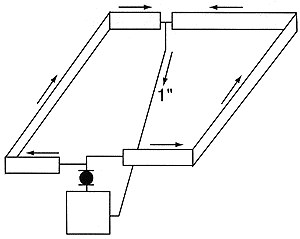
Leave the boiler and head in two directions, assigning part of the 100 foot total to one side and the balance to the other side. Join the two ends together with a single pipe and return to the boiler.
Q: Will that common pipe have to be larger than 3/4"?
A: Yes, in this case, it would be 1".
Q: How come?
A: Because it has to carry the combined flow of both sections of baseboard. If the common return pipe is too small, you won't get the flow you need through the baseboard.
Q: What determines the flow I need through the baseboard?
A: The baseboard manufacturer. Let's take another look at that rating chart.

Notice how they list the heat output per linear foot at 1 gpm and 4 gpm. This has been a testing standard for many years. The 4 gpm flow rate is a maximum because if you make the water move faster than this you'll get velocity noise.
Q: What's that?
A: Velocity noise is the sound water makes when it moves too quickly through a pipe. In hydronic heating, the limits are:
- Not faster than 4 feet per second in pipes 2" and smaller
- Not faster than 7 feet per second in pipes 2-1/2" and larger.
Most equipment manufacturers give limits to the velocity they want to see flowing through their equipment. In the case of 3/4" baseboard radiation, 4 gpm is the limit.
Q: Can high velocity flow cause any other problems?
A: It can cause erosion of the pipe and early failure of the system. It pays to stay within the limits.
Q: Is that why the common return pipe on the split loop is larger than the baseboard?
A: In part, yes, but that common return also has to handle the combined flow of 8 gpm from the two lengths of baseboard. Remember, you sized that baseboard to deliver 61,000 Btu/hr. According to the rating chart, you have to circulate 4 gpm through the element to get that per-linear-foot output. That's 4 gpm going each way in the split loop. When the two flows join on the return side, you have to accommodate a total flow of 8 gpm. That's why you need a 1" pipe. One-inch can handle the combined flow without velocity noise.
Q: Suppose I joined the two sections of the split with 3/4" pipe. What would happen then?
A: If the two sides of the split loop were in balance, you'd probably get about 2 gpm flowing through each side. The flow limitations through the common pipe sets up what happens in each side of the split loop.
Q: How will this affect my system?
A: You'll get less heat from the baseboard.
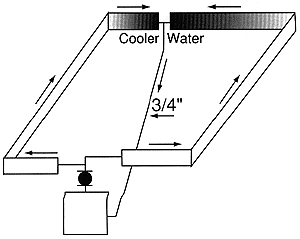
Q: Will I notice this?
A: Probably, but again, only on the colder days of the year.
Q: What's the best way to get the start-up air out of a split loop?
A: Use two purge valves, one on each side of the split loop.
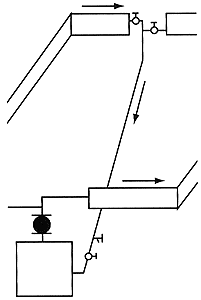
Purge the air out of one side and then the other. Make sure you do them separately. If you try to purge both sides through a single valve, the air will get stuck in one side and you'll have no heat in that side of the loop. Keep this in mind if you're troubleshooting a no-heat call on a split-loop job. Those purge valves are often in the ceiling of a finished basement. You may have to do some work to find them.
Q: Suppose I'm working with a common, water-lubricated circulator. You know, the kind that come pre-mounted on "packaged" boilers. How long can my total loop be?
A: Based on the maximum head pressures these little pumps can develop at the flow rates you'd expect to see in a loop system, a good rule of thumb is to keep the total loop (to and from the boiler) under 170 linear feet.
Q: Suppose my loop has to be longer than that?
A: You'll have to use a circulator with more head pressure.
Q: What about a three-piece circulator. They produce less head so will my loop have to be shorter?
A: Yes, a good rule of thumb is to keep the total loop length under 130 feet.
Q: Does the pipe size have anything to do with this?
A: Not in terms of the pump head, it does affect the flow rate and the circulator's ability to move heat from the boiler to the radiators. For instance, if you were using a small, water-lubricated circulator on a 1/2" loop, you could move the water the same distance as you could if you were using a 3/4" loop (about 170 feet), but you wouldn't be able to transfer as much heat through the 1/2" loop as you would through the 3/4" loop.
Q: Why does copper fin-tube baseboard sometimes make noise when it gets hot?
A: If you raise the temperature of copper by 125 degrees F (as you will if you start out with 65-degree F water and end with 190-degree F water), it will grow by 1.4 inches per 100 feet. That's quite a bit of expansion, and that accounts for the "ticking" noises you frequently hear when the hot water first enters the baseboard.
Q: What can I do about that noise?
A: Many copper fin-tube baseboard manufacturers use plastic gliders to lessen expansion noise. Others offer expansion compensators, which you'd use on long runs to take up the growth of the copper. Another good way to eliminate expansion noise is to operate the system with an outdoor-air reset control. Set up this way, the circulator runs continuously and the water temperature varies with the outdoor conditions. You don't have the sudden movement of hot water into cold copper as you do with a single-temperature system so you avoid most of the expansion noises.
Q: Every now and then I hear a loud bang in my copper-fin tube loop. How come?
A: It's probably caused by a pipe expanding against a too-small hole in a wooden floor or a wall. Copper grows in diameter as well as in length when heated. If it passes through a hole that's too small it will "grab" the wood. Then, as it expands in length, it will lift the floor slightly and let it go when there's enough force to break the pipe's grip. That's the bang you hear. You solve the problem by widening the hole.
Q: Sometimes I hear a humming sound coming out of the baseboard. If I tap the enclosure or the element, the noise goes away. What's causing that?
A: Again, if the loop touches something solid such as the floor or a metal beam it will transmit the sounds of the circulator or the burner through the system. Sound travels further through solids and liquids than it does through air so these vibration noises can show up just about anywhere. The cause and the symptom are sometimes in different rooms. If the noise goes away when you tap the enclosure or the element, look for places where the pipe makes tight contact with the building and give it some space.
Q: If I have to install a baseboard loop on a house without a basement, how can I get past the doors?
A: If the house is on a concrete slab, you'll have to either go over or under the doors. If you go over the doors, the pipe will have to be inside the walls. Be very careful to insulate it well to keep it from freezing in the dead of winter. If you decide to go under the door, you'll have to trench out the concrete.
Q: Can I have problems if I bury the copper pipe in concrete?
A: Yes, because copper and concrete expand at different rates you might develop leaks as time goes by. Also, some of the ingredients in concrete can be corrosive to copper. In some areas, builders used concrete containing cinder ash, for instance. This really does a job on copper tubing over the years. It's a good idea to insulate the copper from the concrete with a suitable material. Foam pipe covering works well.
Q: Is there a way I can zone each room in a loop system?
A: Yes, you can do it with thermostatic radiator valves.
Q: What are they?
A: A thermostatic radiator valves, or TRV, is a self-contained, non-electric zone valve.

You may remember these from Chapter One. A TRV has two parts: a normally open, spring-loaded valve, and a temperature-sensitive valve operator. You pipe the valve into the line. The operator senses the room temperature and throttles the flow of water through the radiator. You can set the TRV to maintain any room temperature between 50 and 90 degrees F. The circulator operates continuously in when you use TRVs.
Q: If I use them on a loop system, won't the first TRV on line shut off the flow to the whole loop when it's satisfied?
A: Normally, it would, but when you use these valves on a loop system, you also use a bypass line around the element.

The bypass line is smaller than the baseboard. When the TRV begins to throttle, the water passes over the element and moves on to the next room. In a strict sense, you don't have a one-pipe loop system once you add TRVs, but you do gain a lot of control and solve your heat balancing problems once and for all because TRVs also compensate for heat gain. If it's a sunny day, or if there are a lot of people in the room, the TRV senses the rise in the air temperature and throttles the flow of hot water through the element. TRVs put the home owner in control.
Leave a comment
Related Posts

In this all-technical three-hour seminar, Dan Holohan will give you a Liberal Arts education in those Classic Hydronics systems. He’ll have you seeing inside the pipes as...
We always have turkey for Thanksgiving. I mean who doesn’t? My job wasn’t to cook it, though; it was to eat it.